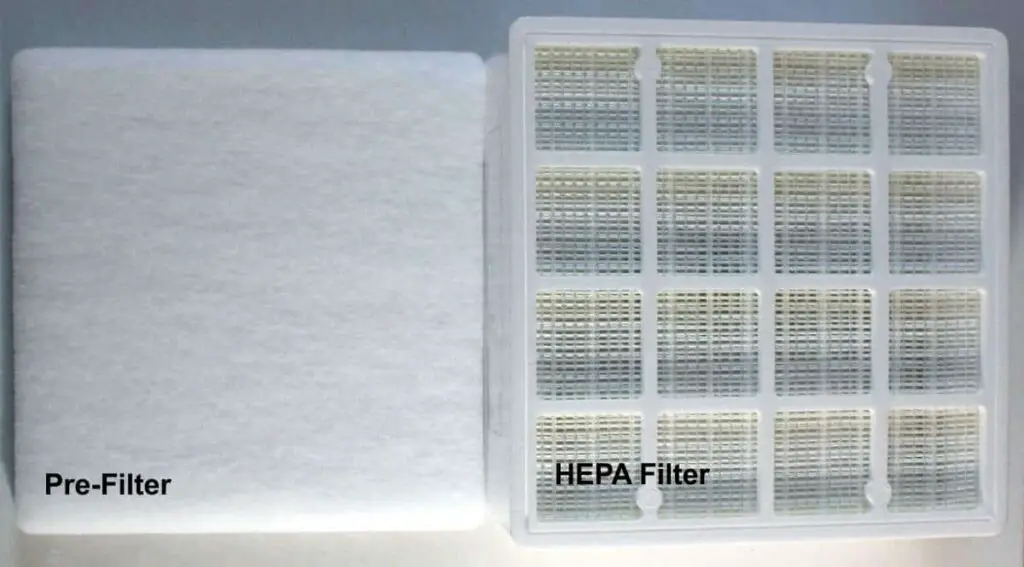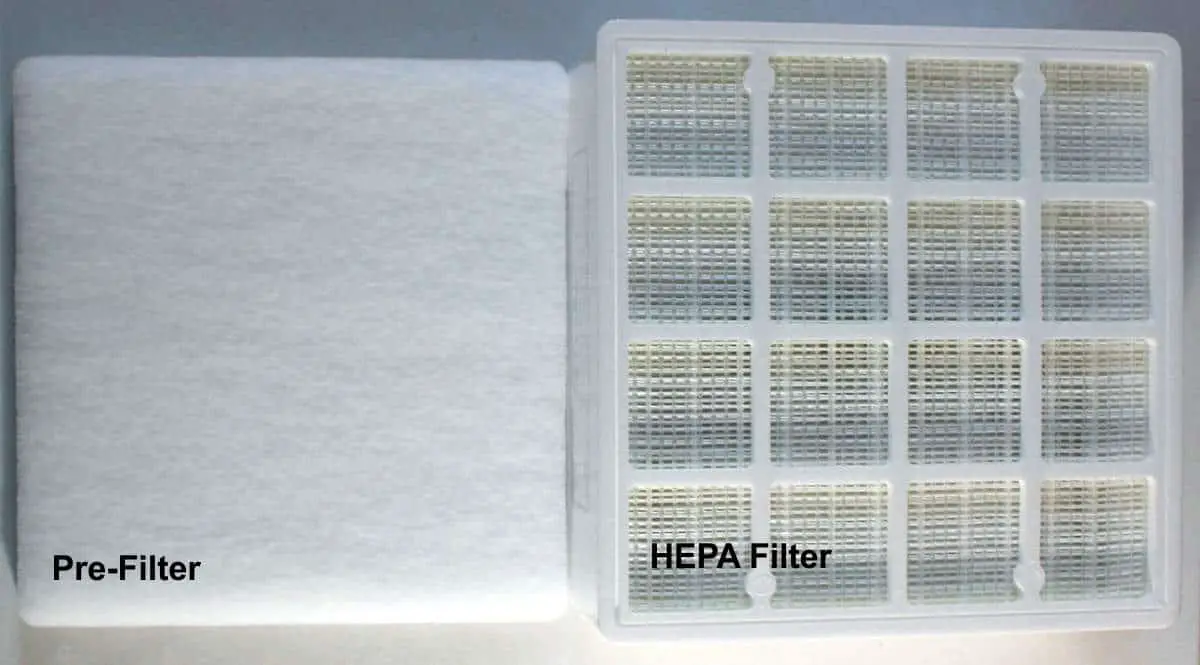As particles and chemicals are collected by an air purifier, it will inevitably need some servicing. Cleaning only applies to some parts of the purifier.
As a general rule only the air purifier casing and pre-filter can usually be cleaned. The usual HEPA filters are too delicate to clean. HEPA filters and carbon filters are usually replaced rather than cleaned.
Two parts of the air purifier are relatively straightforward to clean-the casing and the pre-filter. Depending on the type of HEPA filter it may be able to be cleaned, but whether this is a good idea is another matter. The problems are outlined below.
Cleaning the Casing of the Air purifier
It is best to consult the manufactures instructions befro you clean an air purifier, but the following is generally what is recommended. Disconnect the air purifier from the mains electricity. The air purifier can now be opened and a handheld vacuum used to vacuum any dust out of it. Then both the external services and internal surfaces of the air purifier can be cleaned with a damp cloth. A dry cloth should then be used to dry the inside of the purifier.
Some manufacturers, e.g. Winix, recommend cleaning the inside of the air purifier every 1 to 2 months. I must admit that I clean my air purifiers about once a year, and even then I find very little in the way of dust in them. It really depends on the amount of dust in the environment where the air purifier is on and the type of air purifier.
Cleaning the Prefilter of an Air Purifier
This varies from manufacturer to manufacturer. There is general agreement that excess dust should be vacuumed off the filter. However, after this some manufacturers suggest cleaning with water if only if it is excessively soiled. Some suggest simply putting the pre-filter in the washing machine. Other manufacturers suggest washing the pre-filter in water, with no detergent by hand.
Washing HEPA Filters-Disposable Filters Should NEVER be Washed
Disposable HEPA filters are extremely delicate and easily damaged, so washing a standard HEPA filter makes it 50% less efficient. This effectively makes it useless.
The vast majority of filters are disposable. There are some permanent filters made from glass fiber. If the filter is made of glass fiber then theoretically it can be cleaned.
Standard Disposable HEPA Filters Are Delicate
HEPA filters are made of “coarse glass fibers, coated animal hair, vegetable fibers, synthetic fibers (such as polyester or nylon), synthetic foams, metallic wools, or expanded metals and foils,” -EPA . In practice most filters are made of an 80/20 mix of polyester and cellulose with an ePTFE surface coating.
Washing a standard HEPA filter makes it 30% less efficient
One study found that following washing the airflow through the filter went up 20%. However, the particle capture fell 50%. Overall, the efficiency of the filter went down 30%. It was felt that washing it created disruption of the filter fibers leading to holes in the filter.

“Permanent” HEPA Filters Can be Washed
Glass fiber filters may be referred to as permanent filters. These are water-resistant and can potentially be washed. You should be careful how you handle them as any bending or impact to the filter can break the glass fibers. This can create defects through which unfiltered air can pass.
You should check with the manufacturer before washing your filter. Even then, because of the potential problem with ultrafine particles outlined below, I would recommend asking them specifically the following question. “If I wash this filter will need to impair its ability to capture particles of 3 nanometers in diameter?”. If they cannot answer this question, which is likely, I would recommend that it is safer to buy a new one rather than trying to wash the filter.
Ultrafine Particles are a Particular Concern if a HEPA Filter is Cleaned
Ideally, a HEPA filter needs to trap particles as small as 10 nm ( (nm=1/1000 of a micrometer). The particles less than 0.1 µm form 90-95% of the particles in the air. These are ultrafine particles (UFPs). It is also these very small particles that get so deep into our lungs that they can enter our bloodstream. Larger particles are less important as I deposit them in the upper airways.
When particles are measured, we only reliably detect those particles that are 500 nm in diameter or larger with the usual particle counters. So any testing you see of HEPA filters assumes that what happens at 500 nm size also applies to these smaller particles. Obviously handling a filter in a way that does not let 500nm particles through may damage it enough to let 20 nm particles through.

The particles are so small that even a very small amount of disturbance to a HEPA filter which could create defects in the filter is a concern. For this reason, I think it is better to replace HEPA filters rather than disturb them by trying to clean them.
Other Cleaning Techniques That Have Been Used to Clean Filters
1) Tapping it out
Tapping the filter on a hard surface will remove the loosest material from your filter. This is particularly unsuited to glass fiber filters as it may break the fibers leaving defects. Unfortunately, as it may damage the filter and so is not recommended.
2) Vacuuming
Vacuuming the filter whilst using a brush to dislodge particles has been used. Vacuuming in one study increased the clean air delivery rate by 10% on average, but can make some filters worse. When vacuuming a disposable filter, they saw evidence that the fibers in the HEPA filter were disrupted. So this is another method that is not recommended.
3) Air compressor
An air compressor works well to remove the debris without damaging the filter. If you don’t have one in your workshop, you can buy compressed air in a can – known as a gas duster. You can pick them up fairly cheaply on Amazon, or a big department store like Home Depot.
A can of compressed air has a limited use, and you throw it away after it’s empty. These blow you the most stubborn particles.
Short bursts <1 second of compressed air should be used. Blow in the opposite direction to the air flowing through the air purifier. So from the clean side towards the dirty side.
As mentioned above, I would not recommend any of these methods.
Carbon Filters Can be Cleaned of Dust But Not Chemicals
For some models of air purifiers the activated carbon filter can be washed if it is coated with dust, eg some of the Winix air purifiers. However the chemicals that are stuck to the carbon will not be removed by washing. This is partly because it is difficult for water to get into the very very tiny fissures in the carbon because of the surface tension. Even if water does penetrate into these fissures many of the chemicals will not be water-soluble or will be strongly bound to the carbon and not removable at room temperature.
Used activated carbon can be reactivated but this requires heating to 900°C. This would destroy the structure of any filter currently in use. Also, when it is reactivated the chemicals adsorbed onto it surface are released and at 900° C can be toxic.
However washing off the dust will improve air flow through the filter.
Cleaning Other Types of Air Purifier
It is essential to clean an air purifier that uses an electric charge to purify the air. The elecrodes, usually wires, will periodically need cleaning. This is because dust can accumulates on the wires leading to a decrease in efficiency.
How to know when to clean an air purifier
The manufacturer will give you guidelines in the manual. However, your circumstances may be different from the manufacturer’s assumed average pollution levels. You may have less pollution in your home than average and wish to change the filters and clean the air purifier less often.
As particles in the air cannot be seen or smelt, so it is best to test your air periodically with an air quality meter. These can be bought very cheaply for as little as $35. Similarly meters for detecting chemicals in the air, formaldehyde and volatile organic compounds, start from around $80.
There are later signs of your air purifier needing cleaning/filters replacing. For instance, noticing that the air coming out of the air purifier is now stale, musty, and/or dusty. Also, if your allergies might have begun to flare up. These are signs your air purifier filter needs cleaning or replacing.
In the case of allergies, you will notice a gradual increase in symptoms. However, because your filter gets full of contaminants gradually, you might not notice that your filter needs changing until it is way overdue.
Also, some filters have sensors, and a warning light will display on it when it’s time to change the filter.
How Often Should you Replace the filter on your air purifier?
You should check the manufacturer’s guidelines, but some general recommendations can be found in this post.
This table shows examples-
| Manufacturer and Model | Filter Type | Filter Change Frequency |
| Germ Guardian AC4825 | Filter | 6 months |
| Levoit Core 300 | Pre Filter | 6-8 months |
| True HEPA & Activated Carbon Filter | 6-8 months | |
| Coway AP-1512HH Mighty | Odor Filter | 6 months |
| True HEPA | 12 months | |
| BlueAir Blue Pure 221+ | Particle/Carbon Filter | 6 months |
| Honeywell HPA 300 | Pre Filter | 3 months |
| True-HEPA | 12 months | |
| iQair HealthPro Plus | PreMax Filter | 18 months |
| VOC Filter | 24 months | |
| Hyper-HEPA | 50 months |
Conclusion
So it is straightforward to clean an air purifier, obviously you should follow the manufacturer’s instructions. Usually this will be unplug the air purifier. Then vacuum it out, being careful not to touch the HEPA filter. Next with a damp cloth wipe both the internal and external surfaces and then wipe with a dry cloth to ensure there is no retained water in the machine.
The pre-filter can usually be cleaned by vacuuming it and then washing it in water.
The HEPA filter should not be cleaned as this will disturb/damage it–simply replace in line with the manufacturer’s guidelines. Carbon filters cannot be cleaned effectively and should also be replaced.

